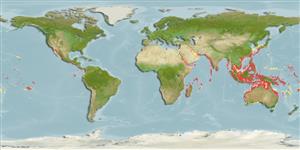Common names from other countries
Environment: milieu / climate zone / depth range / distribution range
Ecologie
; diepteverspreiding 0 - 50 m (Ref. 96667). Tropical
Indo-Pacific: from South Africa to Southeast Asia and Tahiti.
Length at first maturity / Size / Gewicht / Leeftijd
Maturity: Lm ? range ? - ? cm Max length : 7.0 cm CW mannelijk/geslacht niet bekend; (Ref. 343)
Shows distinctive broad blue and white bands on the legs when alive.
Occurs from the intertidal zone to a depth of about 20 m. Prefers rocky areas and reefs (Ref. 343) and muddy bottoms (Ref. 106287).
Life cycle and mating behavior
Geslachtsrijpheid | Voortplanting | Kuitschieten | Eieren | Fecundity | Larven
Members of the order Decapoda are mostly gonochoric. Mating behavior: Precopulatory courtship ritual is common (through olfactory and tactile cues); usually indirect sperm transfer.
Ng, P.K.L. 1998. (Ref. 343)
Status op de Rode Lijst van het IUCN (Ref. 130435)
Status bij CITES (Ref. 108899)
Not Evaluated
Not Evaluated
Gevaarlijk voor mensen
Harmless
Gebruik door de mens
| FishSource |
Tools
Internet-bronnen
Estimates based on models
Preferred temperature
(Ref.
115969): 24.5 - 29.1, mean 28 (based on 1490 cells).
Kwetsbaarheid
Low vulnerability (10 of 100).
Prijsklasse
Unknown.
